

WASHINGTON g a rdener
the magazine for gardening enthusiasts in the Mid-Atlantic region
Tulip Types for Every Garden
Cedar Waxwings Versatile Lemon Verbena Shade Garden Basics
Sculpture Garden at River Farm
Dealing with Fall Webworm
Urban Tree Summit
New Patty Pan Squash ‘Green Lightning’ Garden Book Reviews and Reader Contest
Glenmont Forest Community Garden
How to Choose and Care for Fall Mums


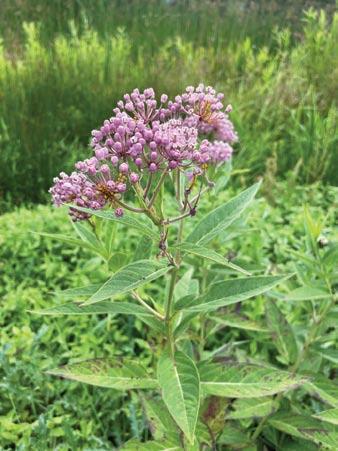

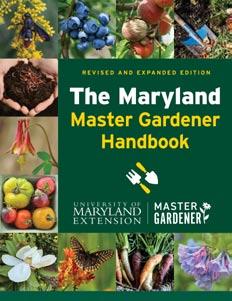
Your Ad Here

Are you trying to reach thousands of gardeners in the greater DC region/Mid-Atlantic area? Washington Gardener Magazine goes out on the 15th of every month. Contact KathyJentz@gmail.com or call 301.588-6894 for ad rates (starting from $200) The ad deadline is the 10th of each month. Please submit your ad directly to: KathyJentz@gmail.com

Need a Garden Club Speaker?
Washington Gardener Magazine’s staff and writers are available to speak to groups and garden clubs in the DC region and ONLINE! Call 240.603.1461 or email KathyJentz@gmail.com for available dates, rates, and topics.

Barry Glick
Sunshine Farm and Gardens 696 Glicks Road Renick, WV 24966, USA Email: barry@sunfarm.com www.sunfarm.com RARE AND EXCEPTIONAL


www.greenspring.org

Green Spring Gardens
A “must visit” for everyone in the metropolitan Washington, DC, area. It’s a year-round goldmine of information and inspiration for the home gardener. It’s an outdoor classroom for children and their families to learn about plants and wildlife. It’s also a museum, a national historic site that offers glimpses into a long, rich history with colonial origins. Located at 4603 Green Spring Rd., Alexandria, VA. Information: 703-642-5173.
Want to attract bees and other pollinators to your garden? Choose single-flowered and botanical tulips. Photo of Tulipa ‘Abanda’ courtesy of ibulb.org.

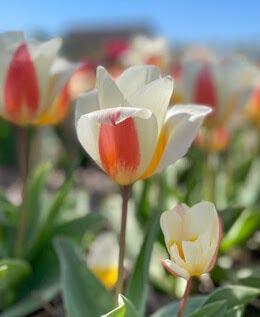
Kenneth Cole Schneider.
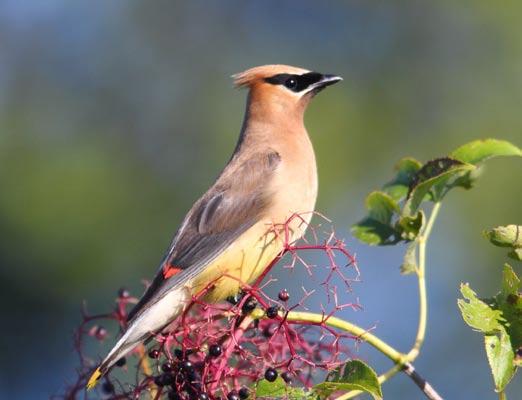

Photo
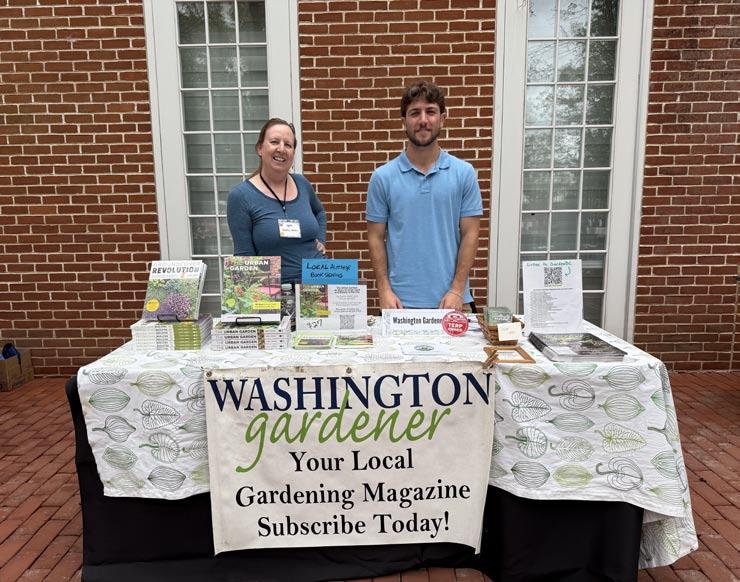
Tapping into Intuition
I recently attended a talk by executive coach and best-selling author Megan Taylor Morrison about intuition at the Cultivate conference in Columbus, Ohio. Morrison was the featured speaker at the Women in Horticulture luncheon. Her talk was entitled, “The Intuitive Edge: Unlock Success through Your Inner Wisdom.”
Morrison’s talk gave examples of intuition applied in real-life situations and for business decision-making. She walked us through a few exercises to recall where we had used intuition in the past and how that had worked out for us.
The other business leaders at my table shared their levels of comfort in using intuition as a guide in their personal and professional lives. They also described past successes and failures with intuitive thinking. I found this sharing to be helpful to destigmatize the use of intuitive decision-making in business.
Professor Joel Pearson, who has a PhD in neuroscience, defined intuition as “the learned use of unconscious information for better decisions and actions.” Pearson asserts that “intuition is real. We can create it and measure it in the lab, and we now understand it with the neuroscience and psychology we already have.”
I know I’ll be paying more attention to my intuition in making decisions not just in business, but also in the garden. Sometimes, things just make sense or feel right when you “trust your gut” instead of going with what is expected or mandated in traditional practice. I hope you tap in with me and we’ll see how it goes.
Sincerely,

Kathy Jentz, Editor/Publisher, Washington Gardener, KathyJentz@gmail.com
Credits
Kathy Jentz Editor/Publisher
Washington Gardener 826 Philadelphia Ave. Silver Spring, MD 20910
Phone: 301-588-6894
kathyjentz@gmail.com www.washingtongardener.com
Ruth E. Thaler-Carter Proofreader
Cavit Ireland
Ellen Isaacson Interns
Subscription: $20.00
• Washington Gardener Blog: www.washingtongardener.blogspot.com
• Washington Gardener Archives: http://issuu.com/washingtongardener
• Washington Gardener Discussion Group: https://groups.google.com/g/ washingtongardener/
• Washington Gardener Twitter Feed: www.twitter.com/WDCGardener
• Washington Gardener Instagram: www.instagram.com/wdcgardener
• Washington Gardener Facebook Page: https://www.facebook.com/ WashingtonGardenerMagazine/
• Washington Gardener YouTube: www.youtube.com/ washingtongardenermagazine
• Washington Gardener Amazon Store: www.amazon.com/shop/wdcgardener
• Washington Gardener BookShop: bookshop.org/shop/WDCgardener
• Washington Gardener Podcast: https://podcasters.spotify.com/pod/ show/gardendc/
• Washington Gardener Plant Store: https://shop.kathyjentz.com/
• Washington Gardener is a woman-owned business We are proud to be members of:
· GardenComm (formerly GWA: The Association for Garden Communicators)
· Green America Business Network
· National Garden Bureau
· One Montgomery Green
· Ladies in the Landscape
· Potomac Rose Society
· American Horticultural Society
· Maryland Nursery, Landscape and Greenhouse Association
Volume 20, Number 7
ISSN 1555-8959
© 2025 Washington Gardener
All rights reserved. Published monthly. No material may be reproduced without prior written permission. This magazine is purchased by the buyer with the understanding that the information presented is from various sources from which there can be no warranty or responsibility by the publisher as to legality, completeness, or technical accuracy.
Your editor and intern Cavit Ireland at the recent TerpFest in College Park, MD.
Reader Contest
For our October 2025 Washington Gardener Reader Contest, we are giving away three copies of The Square Foot Gardening Planner from Cool Springs Press (value $23 each, https://amzn.to/4mKRC4W).
The Square Foot Gardening Planner: A 3-year Journal for Recording the Planning, Planting, and Care of Your Square Foot Garden is the one-and-only official planner of the Square Foot Gardening Foundation, filled with all the planning tools and data-tracking logs that generations of Square Foot Gardeners have been asking for. The intensive planting, prescribed spacing, and succession cropping used in the square foot gardening method mean a greater need to plan in advance and keep track of changes. This planner gives you all the tools you need to do just that.
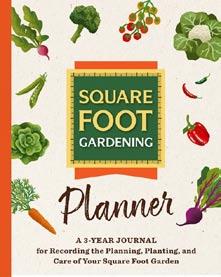
To enter to win The Square Foot Gardening Planner, send an email by 5:00pm on Friday, October 31, to WashingtonGardenerMagazine@gmail.com with “Square Foot Gardening Planner” in the Subject line and in the body of the email. Tell us what your favorite article was in the October 2025 Washington Gardener issue and why. Please include your full name and mailing address. Winners will be announced and notified on/about November 1. Replies might be published. o
Your Ad Here
Are you trying to reach thousands of gardeners in the greater DC region/MidAtlantic area? Washington Gardener Magazine goes out in the middle of every month. Contact KathyJentz@gmail.com or call 301.588.6894 for ad rates (starting from $200). The ad deadline is the 5th of each month. Please submit your ad directly to: KathyJentz@gmail.com.

Plant a Row for the Hungry (PAR) is an easy program to participate in and really does not take any extra resources than what you may have in your garden. In normal times, about 35 million people wonder where their next meal will come from. Most of these are children. That’s where PAR steps in.
PAR is such a simple program: It urges gardeners to Plant A Row (or a container) dedicated to feeding the hungry, and then take the harvest to someplace or someone that needs it. Once you have donated, send an email to KathyJentz@gmail.com with the total (in pounds and ounces) of what you gave. That is all there is to it. Easy. Effective. Adaptable and Helpful.
My favorite article in the September 2025 issue of Washington Gardener was the Editor Letter and the question, “How ‘wild’ do you dare go?” Over the past 25 years. I have planted a number of shade trees, and as they mature, the garden below slowly changes, as plants die out from lack of sun and I experiment with new plants that can better handle the shade. Beyond experimenting with plants, I have also become more wildlife-friendly, letting some pests and “volunteer” plants grow where they will. Where is the balance between wildness and care?
Rick Borchelt’s article about creeping cucumber and how plants can morph from threatened to threatening sheds more light on how dynamic that decision-making will have to be.
~ John Rebstock, Cheverly, MD
My favorite article in the July-August 2025 issue of Washington Gardener was the one about sunflowers. I really appreciated learning that they may be planted in mid-summer to produce flowers in the autumn.
I am a beekeeper and enjoy growing sunflowers from seed for both pollinators and birds. However, I have never attempted succession-planting sunflowers. The article by Barbara Melera has inspired me to give growing new sunflowers in the mid-summer time frame a try for the benefit of all of our birds and bees!
~ Don Truitt, Silver Spring, MD
Favorite article in the July-August 2025 Washington Gardener issue is “Black Cohosh.” Why? Because I just purchased one of these plants and appreciated the extra detail information on growing it successfully.
~ Cheryl Derrington, Ellicott City, MD
Though the magazine regularly holds numerous enlightening features, I was particularly intrigued by the wealth of information contained in “How and When to Repot Houseplants” in the April 2025 issue. Some of mine are beginning to outgrow their pots, so this was especially timely. Who knew to “skip the pebbles”? I will definitely be sharing that tidbit among my fellow gardening friends.
~ Smita Parida, Rockville, MD o
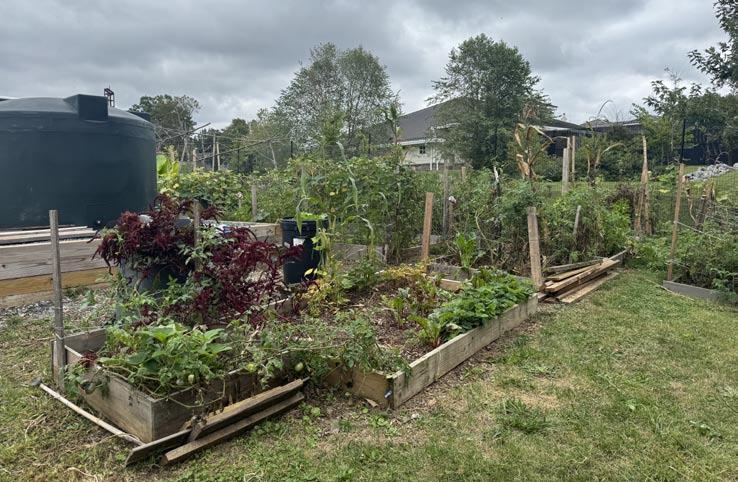
Glenmont Forest Community Garden
Anyone can reap the benefits of the Glenmont Forest community garden at the intersection of Georgia Avenue and Randolph Road in Silver Spring, MD: Just ask Jorge!
On Sunday, September 21, Jorge Diaz, the head garden keeper of the community garden right next to Glenmont Fire Station 18, showed me around the flourishing local garden at the Glenmont Forest Civic Association Fall Art & Harvest Block Party. Although the day was gray and dreary, the company was not. Jorge’s knowledge and passion for the garden was delightful. He showed me the different plots, and we discussed how the community plays into this green space. Community members can register to have their own plots through the Glenmont Forest Neighbors Civic Association. Once they are registered, all they have to do is contact Jorge, and the planting can begin.
The garden is steadily growing as more and more community members get involved—currently, there is still open green space ready for new gardeners.
Countless plants were spread across the various plots, including red and black cherry tomatoes, green peppers,
corn, regular basil, lemon and Thai basil, different bean plants, as well as banana plants. As we walked through the garden, Jorge told me about the different types of recipes he and other people have used with these plants, like soups using the various kinds of white beans, stir fries using the different types of basil, and tamales using the banana tree leaves. He explained that while the climate isn’t warm or humid enough for the banana plants to bear their fruit, their leaves are still useful in various recipes.
There was also an array of tables promoting various organizations and small businesses. Some of these organizations included One Montgomery Green; Montgomery Parks; and Sonia Climaco’s jewelry business, Sonia’s Craft Design. I bought one of her stunning handmade bracelets, personally crafted by Sonia. What caught my eye
was the bracelet’s unique blend of circular and rectangular stones, featuring earthy tones of blue, green, brown, and white.
I wandered around the festival for a little while, happy to see families and community members enjoying games, dancing, cornhole, a piñata, face painting, a bouncy house, and more, all centered around the vibrant Gathering Tree public art project.
I had the pleasure of meeting Jim Epstein, president of the Glenmont Forest Civic Association. He showed me around the festival a bit more, telling me about the association and its mission to bring together the Glenmont community. He introduced me to Wendy Howard, executive director of One Montgomery Green. Wendy told me a little bit about the nonprofit, and their mission to facilitate environmental responsibility, educate community members about conservation and native species, transition to a sustainable economy, and overall improve the quality of life of Montgomery County residents. We compared jewelry pieces that we each bought from Sonia’s Craft Designs.
The event served as an inspiring reminder of how vital community and
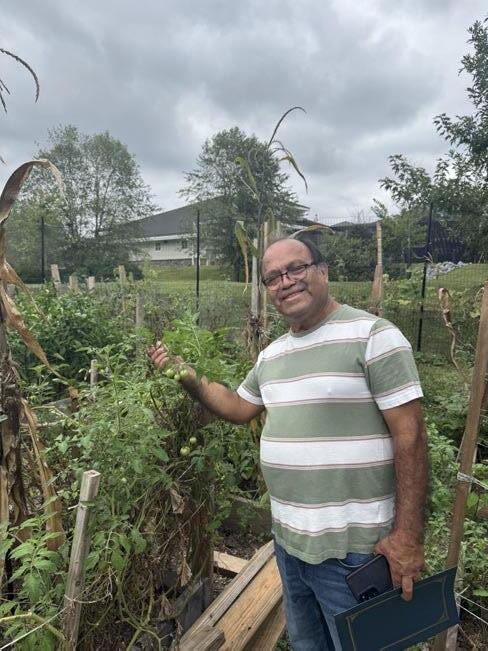
Text and photos by Ellen Isaacson
environmental involvement truly are. Instilling an appreciation for cultivating and nurturing plants in both current and future generations is essential for a sustainable future. A garden can’t thrive with just one set of hands, Jorge hopes more people will dig in and help it grow. o
Ellen Isaacson is an intern this fall semester with Washington Gardener. She is doublemajoring in journalism and French language and literature
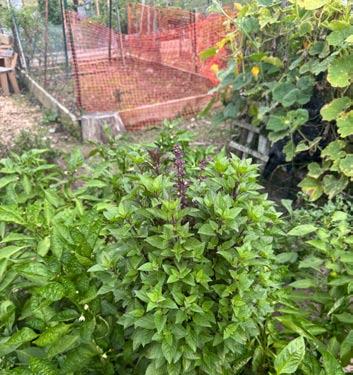


The Azalea Society offers membership to anyone with an interest in azaleas, from home gardeners, collectors and students to plant professionals. The Azalea Society website (azaleas.org) is the source of information about azaleas.



IS OUT NOW! By
Published by Cool Springs Press Order it today at: https://amzn.to/3IlYHYL
“Groundcover Revolution is must-have book for anyone who is interested in having less lawn, fewer weeds, and reduced mulching. The properties charts will save the reader time and money, the pictures provide inspiration, while the detailed plant portraits give the focused information needed for creating beautiful, functional landscapes.”
―C.L. Fornari, GardenLady.com
The Gathering Tree sculpture (below) is by the artist team of Sandra Perez-Ramos and Stuart Diekmeyer.
What I Grew this Summer
We asked the summer interns to tell us about their growing experiences at our garden plot at the Fenton Community Garden this past summer

Colin’s Cucumbers and Zucchini
By Colin Davan
With a pile of seeds spread across the table, I was left with some tough decisions. After my fellow summer interns Miguel and Ian had picked their tomatoes and peppers, I was tasked with four seed packs: two kinds of cucumbers and two types of zucchini plants. However, these were not just any vegetable plants. Each brought their own unique challenges and tasks, starting with the cucumbers. I had one pack of Slicing Cucumber and another of Japanese Climbing Cucumber, which required a tomato cage surrounding it, hence the name.
Moving to the zucchini, I was in charge of the Nimba Squash Zucchini and Dark Star Zucchini.
The summer plot got off to a hot start with Miguel and Ian planting their tomato and pepper seedlings. In my first week, I spent my time thoroughly weeding and clearing out the section of the plot I was given. Since these vegetable plants required so much space, I delayed my seed sowing until the second week.
The second week, I returned and formed four small mounds spaced out a couple of feet from one another. After I planted the seeds in each mound, topped them with compost, and sur-
rounded them with straw, I protected them with small wire pieces (hardware cloth), so the urban pests would not come to take my special seeds or baby seedlings. I stood back and took a picture of the dirt mounds. I began to wonder: What will come of these seeds? Will I find any success in the garden this summer?
After returning the following week, I saw a glimpse of success beginning to push out from the mounds. Small green seedlings had begun to arise, with a few pesky weeds around them. I tended to my four small mounds and returned the following week.
I saw an increase in seedlings that were beginning to flourish. Both of the cucumber plant mounds exploded with several small seedlings that I would eventually thin down to two each. However, I was not seeing close to the same progress with my zucchini plants. I would come to find later on that my zucchini plants would ultimately give me problems all summer. The Dark Star never produced a seedling and the Nimba Squash grew much more slowly than my cucumbers. However, that did not deter my garden grind. We planted a different zucchini squash variety (‘Zucchini ‘Black Beauty’) in Dark Star’s former spot and gave extra care to my zucchini each week.
As the blazing hot weeks in the garden went on, my Nimba Squash and both cucumbers would grow at exponential rates. Powerful rainstorms all throughout July, hot sunny days, and a little bit of fish fertilizer created the perfect mix for results.
By late July and early August, I had begun to see flowers and small cucumbers, but no actual zucchini yet. A bit of concern began to creep in as the deadline for submissions in the Montgomery County Fair was quickly approaching, and I did not have enough similarlooking cucumbers or zucchini ready to submit an entry.
I was able to harvest many cucumbers from my Japanese Climbing plant and ended up submitting them to the DC State Fair (see results at end of the article). While the zucchini plants struggled, I was able to get a nice zucchini, which I used in a chocolate zucchini cake. (Thanks, Kathy, for the recipe!)
At the end of my Fenton journey, I realized this experience was not only
about producing cucumbers and zucchini, but also of overcoming obstacles and strengthening my patience. I am so incredibly grateful for the opportunity with the Washington Gardener Magazine this summer, because I got to enhance my journalistic skills while also being on the Fenton plot, working in a nice community garden.
UPDATE: The cucumber won first place! See the full DC State Fair results at https://www.dcstatefair.org/2025contest-results. o
Colin Davan was an intern this summer session with Washington Gardener. He is a rising senior at the American University in Washington, DC, studying journalism with a minor in history. He grew up just outside of Boston in two towns (Hopkinton and Framingham), both with backyards always filled with a wide variety of flowers, herbs, vegetables, and fruits.
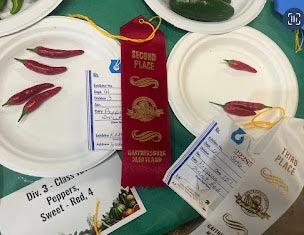
Prize-Winning Peppers
By Ian Ferris
I began my summer as an intern with a choice: Which vegetable would I grow tomatoes, cucumbers, or peppers? It felt like choosing a starter Pokémon. In my haste to select the best option, I chose the one that intrigued me the most: peppers—as tasty to the mouth as they are to the eye. And what a choice it was.
I began with small pepper plants of four varieties. Planting them brought me back to my days of working on a farm, where I would plant dozens of plugs without thought. This time was different. I took my time planting these, carefully digging holes with proper spacing and giving these wee plants a good start in their new home.
Next came maintenance as my infants grew up. Peppers don’t need too much work if the growing conditions are right. Every week, I would give them
Colin Davan and cucumbers.
Photo by Ian Ferris.
a good share of water, always feeling that they must be as thirsty as I was in the summer heat. The other tool they needed for success was nutrients. After a couple of weeks of letting them grow, I began giving them a dose of fish fertilizer before they were watered. This ensured they were well-fed and ready to put those nutrients into big, healthy fruit.
Along the way, I helped out with the rest of the garden, pulling weeds from around my peppers and the surrounding areas. I really do hate weeding. I would also help harvest blackberries and attend to any tricky misnomers occurring that Kathy had spotted—mostly hacking away at the pestsome mulberry trees that kept sprouting around the garden and trimming back ambitious plants.
My peppers only encountered some trouble: slight wilting on the bottom leaves, probably due to the frequent tropical-like thunderstorms we’ve endured in Maryland. Beyond that, my only worry was whether they’d produce enough fruit in time for the fair. This seemed hopeless at times, but it was the pepper plant with the smallest fruit — instead of the largest—that surprised me. It grew uniform, delicious-looking peppers that seemed like they would ripen in time.
While I was out of state on vacation, Kathy took care of my peppers and harvested them in time for the fair. These peppers had one last surprise for me. Upon strolling toward the awards table, I noticed they placed second and third in their category. Deep pride filled me. It is this shared feeling among gardeners that makes the whole ordeal worthwhile. Together, the plant and I worked hand in hand to produce a gorgeous and delicious fruit—although the pepper plants did most of the work. For that, I’m grateful to my peppers and to the Washington Gardener for a great summer of growing. o
Ian Ferris was an intern this summer session with Washington Gardener.. He is a rising senior at the University of Maryland studying journalism and sustainable agriculture. He worked on a garden farm near Annapolis, MD, called Maidstone Harvest for two summers, where he learned a lot about growing vegetables in a sustainable and efficient fashion.
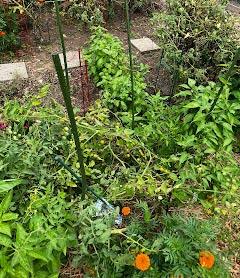
Learning While Growing Tomatoes
By Miguel Zarate
At the beginning of the summer, the other interns and I were given a selection of vegetables to grow throughout the course of the summer. I chose the tomatoes because they had always been a subject of interest for me. I had constantly heard from my mother and grandmother how unruly and difficult to grow they are--needing specific conditions to grow. I decided to take on the challenge. We were growing from seedlings already started in pots. so the difficult task of getting to seed was already taken care of.
On that first day, we took them to the garden to be planted. I also planted a marigold flower right at the edge of the tomato bed. This helps to deter certain pests and keep my tomatoes safe.
With that, the plants were in their spots. I planted five varieties: ‘Marriage Mazinera’, ‘Celebrity’, ‘Green Zebra’, ‘Sun Gold’, and ‘Wild Cherry’ (currant). The Marriage Mazinera ended up not lasting very long. It wasn’t in the best shape when I planted it, so I wasn’t upset about the death of my plant, but I still had hope. I put it in the center, hoping that being in the middle would promote nutrient cross over from the others.
In the following weeks, we developed a routine. After our weekly indoor meetings, we would head to the garden to weed, water, and fertilize. Weeding is definitely my least favorite part of gardening. We also had some aggressive Yarrow, which desperately wanted to be a part of the garden, but I had to pull it out each time it grew and got close to the tomatoes.
When I was a kid, my parents would have me help them in the garden, pulling various weeds from the ground. I hated it. Sitting in the sun and wrestling with plants wasn’t my idea of a fun morning back then.
As an adult, I still didn’t enjoy it, but this time around, it felt like I was growing for myself rather than being told to do it. If I didn’t, my tomatoes would die.
On that subject, the first week of July brought my summer nemesis: blight.
My poor Wild Cherries were afflicted with the blight. I’m a relatively inexperienced gardener, so I did my best to trim the infected leaves, but it didn’t go the best way. The infection stayed with the cherries all the way until the end. Luckily, I got a few tomatoes from it before the fungus claimed the life of another tomato.
Another thing I noticed about my tomatoes was their growth. They started about a foot tall and quickly grew, to just over 2 to 3 feet tall. This led to two things: One, they were all over each other, which caused the blight to jump to other tomatoes, but removing those infected leaves was simple. The other issue was that my tomatoes were becoming unruly neighbors to my cointern’s Ian Ferris’ peppers.
It was on me to wrangle these plants, so I used some string and tomato clips that mostly stopped them from stretching over boundaries.
In the end, I harvested handfuls of small ‘Sun Gold’ tomatoes. For the harvest where we entered the tomatoes in the Montgomery County Fair, I was out of town. Kathy Jentz submitted them for me and they earned third place in the “orange, preserving (aka cherry)” tomato category, which wasn’t something I expected for my first tomato plant. I’m proud of them for growing so well. I will definitely grow more of my own tomatoes in the future.
I’m so glad I had this opportunity with the Washington Gardener: definitely not what I expected for my summer when I switched to journalism, but the experience has been incredible. Growing a plant really teaches you about patience, which is something you need a lot of as a writer and reporter. o
Miguel Zarate was an intern this summer session with Washington Gardener. He is majoring in journalism with a minor in sustainability. His favorite thing to grow in his mother’s garden, where he helps out, is mint, because it is so plentiful.

How to Choose and Care for Fall Mums
Fall chrysanthemums, or “mums,” are a seasonal favorite that brings vibrant color to porches, patios, and landscapes each year, writes Susan Himes, a writer for Texas A&M AgriLife
Their colorful blooms range from sunny yellow and crisp white to autumn shades of orange, red, and lavender. Mums have become as much a part of the fall season as pumpkins and hay bales.
Andrew King, Ph.D., ornamental specialist with Texas A&M AgriLife Research and assistant professor in the Texas A&M Department of Horticultural Sciences at the Texas A&M AgriLife Research and Extension Center in Overton, provided advice for buying and caring for mums so they last as long as possible.
“I grew up growing and selling chrysanthemums,” he said. “They’re widely available and synonymous with fall, but it’s not always easy to keep them looking great.”
Follow these tips from King to find the healthiest plants that best meet your needs.
• Shop early to get the best selection. The later you wait, the fewer fall colors and sizes you will find.
• Choose buds over blooms. Look for plants full of tight, green, unopened buds. They will bloom over a few weeks, providing gardeners with more color for a longer period.
• Avoid stressed plants. Skip mums with yellowing leaves, spindly stems, or few to no buds. Healthy, compact plants will last longer.
• Match the plant to your purpose. Annual mums provide a pop of color for the season, while perennial plants return each year in gardens or landscapes. Your local garden center/nursery can help you choose the right plant. Choosing suitable plants is only the first step. Providing the proper care will keep your mums thriving throughout the entire season. Follow these tips from King to grow mums with long-lasting blooms.
• Water wisely. Too much or too little water can reduce bloom production or kill your mums. Check the soil with your finger and water only when the top feels dry.
• Provide good drainage. Roots need well-drained soil, whether in a nursery pot, planter, or garden bed.
• Find the right light. Mums thrive in full sun, but need to adjust slowly when moving them from a shady spot. Transition them gradually to avoid stress.
• Watch temperatures. Mums prefer temperatures ranging from 60 to 70 degrees. Move them to the shade if it reaches 90 degrees or higher. Conversely, bring mums in containers inside before a freeze.
• Repot if needed. Rootbound plants appreciate more room and rich, peatbased soil.
• Deadhead for more blooms. Pinching off faded flowers encourages new buds and often a second round of blooms. o
A Tulip for Everyone
Combine early-, mid-, and late-blooming tulips to extend the flowering season and enjoy color in the garden for an extra-long time. From playful parrot tulips to classic single early or romantic peony tulips, there is a gorgeous tulip for everyone.
• Single Early Tulips
Flowering: March–April; 10–16 inches
Highlights: Compact, delicate tulips with sturdy stems and among the first to flower. They’re perfect for pots, borders, and front gardens.
• Double Early Tulips
Flowering: April; 12–16 inches
Highlights: These lush tulips resemble peonies and add a luxurious look to your garden. They flower a bit later and do well in sheltered spots or window boxes.
• Triumph Tulips
Flowering: April–May; 16–24 inches
Highlights: These are strong, sturdy flowers that come in a wide range of colors. They are ideal as cut flowers and bloom reliably every year.
• Darwin Hybrid
Flowering: April–May; 20–28 inches
Highlights: Large, goblet-shaped flowers on long stems. They are resistant to wind and rain and, conditions permitting, can return over several years.
• Single Late Tulips
Flowering: May; 20–30 inches
Highlights: Has the classic tulip shape and comes in a wide variety of colors. Perfect if you want to prolong the tulip season.
• Double Late Tulips (Peony Tulips)
Flowering: May; 18–24 inches
Highlights: Lush, full blooms that add a touch of luxury to your garden. Sheltered location recommended due to their heavy flowers.
• Botanical Tulips (Wild Species)
Flowering: March–April; 4–12 inches
Highlights: Perfect for natural-looking gardens, lawns, and rockeries. These tulips will naturalize and return year after year. Because these tulips are lowgrowing, they are perfect for balconies.
• Fringed Tulips
Flowering: April–May; 16–24 inches
Highlights: Striking tulips with a fringed, frosted effect on the petals. They’re often bi-colored and are real eye-catchers.
• Viridiflora Tulips
Flowering: April–May; 16–20 inches
Highlights: Green stripes on petals that give these tulips a modern look. They have an extended blooming period and are ideal for stylish borders.
• Parrot Tulips
Flowering: May; 20–24 inches
Highlights: Playful, serrated edges with irregular contours make these tulips real eye-catchers in the garden.
Fun fact: The parrot tulip gets its name from the jagged, curled, and sometimes multi-colored petals that are reminiscent of a parrot’s colorful plumage.
• Lily-flowered Tulips
Flowering: April-May; 20–24 inches
Highlights: Elegant, slender flowers with petals that flare outward. Perfect for cut flowers.
Find more information about flower bulbs at www.flowerbulbs.com. o
Compact plants with heavy numbers of closed buds typically translates into a longer-lasting bloom. Deadheading spent blooms can also help promote more blooms. Photo by Michael Miller/Texas A&M AgriLife.
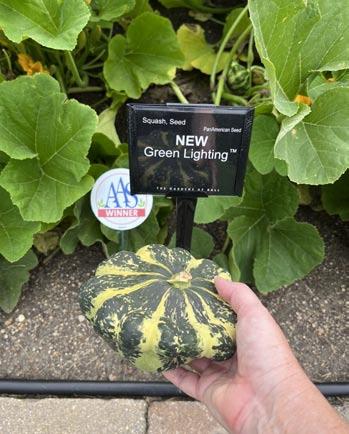
New Plant Spotlight
Squash Green Lightning™
Hybrid Patty Pan Squash
Summer Squash ‘Green Lightning’ (Cucurbita pepo) is an All-America Selections National Award winner. This variety is also known as ‘Green Lighting’ and was given high marks in the All-America Selections trials for maturing fast and early (4045 days), setting it apart from other patty pans, to be one of the first squash harvested during the season. The scallop disc fruit shape, with its attractive green striping, has also been deemed “cute-pretty” for use in home vegetable décor. It truly is an exceptional patty pan that is best harvested at the palm-size stage for the most tender flavor—and its vivid color really makes it stand out. This plant was bred by Joseph Stern and marketed by PanAmerican Seed For more information, visit https://www.panamseed.com/. o
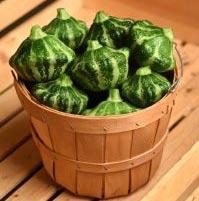
Quick Links to Recent Washington Gardener Blog Posts
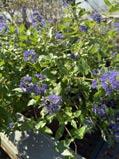
• Blue Mist Shrub Plant Profile
• Battling Poison Ivy
• Meet the New Interns
See more Washington Gardener blog posts at WashingtonGardener.blogspot.com o
October Garden To-Do List
• Cover pond with netting to keep out fallen leaves and debris.
• Harvest sweet potatoes.
• Plant garlic.
• Force buds on Christmas Cactus by placing in a cool (55–60 degree) room for 13 hours of darkness.
• Apply deer-deterrent spray.
• Prevent the spread of disease by cleaning up all infected plants and disposing of them in your trash—not your compost pile.
• Plant cover crops in your vegetable gardens and annual beds (i.e., rye, clover, hairy vetch, winter peas).
• Set up a cold frame, then plant lettuces, radishes, and carrots from seed.
• If you have a water garden, clean out the annual plants and compost them. Cut back the hardy plants and group them in the deepest section of the pond.
• Leave seedheads on Black-eyed Susans, Echinacea, Goldenrod, Sunflowers, and Thistles for the birds to enjoy over the winter.
• Check for bagworms; pick off, bag, and dispose of them.
• Dig up and store potatoes in a cool, dark spot.
• Continue to divide and transplant perennials.
• Rake leaves and gather in compost piles.
• Pick pumpkins at a local pick-your-own farm or visit a local farmer’s market.
• Cut garden herbs and hang to dry in a cool, dry place indoors.
• Start feeding birds to get them in the habit for the winter.
• Attend a local garden club meeting.
• Mulch strawberry beds for winter.
• Turn your compost pile weekly and don’t let it dry out. Work compost into your planting beds.
• Plant evergreens for winter interest.
• Weed.
• Plant spring-flowering bulbs.
• Sow wildflower seeds, such as California Poppies, for next spring.
• Collect dried flowers and grasses for an indoor vase.
• Clean, sharpen, and store your garden tools.
• Lightly fertilize indoor plants.
• Pot up Paper Whites and Amaryllis for holiday blooming.
• Check that all vines are securely tied against winter’s cold winds.
• Collect plant seeds for next year’s planting and for trading.
• Pull out spent summer annuals.
• Plant hardy mums and fall season annuals.
• Water evergreens and new plantings to keep them hydrated this winter.
• Fertilize your lawn and re-seed if needed.
• Dig up any nonhardy Gladioli bulbs, cut off foliage, dry for a week, and then store them inside for the winter.
• Transplant trees and shrubs.
• Gather seeds and label them carefully. Store in a dry location.
• Keep an eye out for the first frost date and insulate plants as needed. In Zone 6, it is expected between September 30 –October 30; in Zone 7, it is predicted for October 15–November 15. o
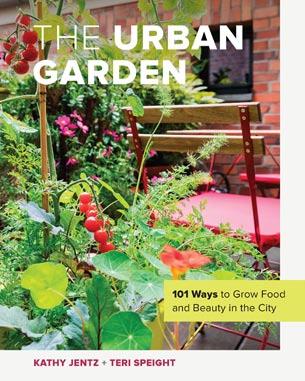
The Urban Garden: 101 Ways to Grow Food and Beauty in the City is all about small-space gardening solutions!
By Kathy Jentz
and Teresa Speight
Published by Cool Springs Press/Quarto Homes
Order it today at: https://amzn.to/3yiLPKU

GardenDC Podcast
The GardenDC podcast is all about gardening in the greater Washington, DC, and Mid-Atlantic area. The program is hosted by Kathy Jentz, editor of Washington Gardener Magazine, and features guest experts in local and national horticulture. The latest episodes include interviews with experts on Growing Onions, Soil Care, and Community Gardening.
You can listen online at https:// washingtongardener.blogspot.com/ or on Spotify, Apple, etc o
Classes, Events, and Plant Shows/Sales
• Saturday, October 11, 10:30am—12n Seed Saving: Harvesting & Storing Your Garden’s Bounty
Kathy Jentz, editor of Washington Gardener Magazine, will teach the art of seed-saving in this hands-on class. Learn when and how to collect seeds, helpful botanical terms, storage tips, and seed lifespans. We’ll process seeds from Kathy’s garden together—yours to take home. Explore techniques for longterm storage, keeping seeds safe from animals, and turning your garden into a sustainable seed factory. Fee: $25. Register at ActiveMONTGOMERY.org.
• Saturday, October 11 Open Garden Tour
The Garden Conservancy is hosting an open garden tour at the Donald Pell Garden in Phoenixville, PA. Fee: $10. Details at https://www.gardenconservancy.org/events/all-events.
• Friday, October 17
Perennial Plants for the Mid-Atlantic Region & How to Use Them in Landscapes
The annual Perennial Plant Conference will be held at the Scott Arboretum & Gardens in Swarthmore, PA. Regular registration (in-person and virtual): $149. Details at https://www.perennialplantconference.org/.
• October 17–19
Lilyhemmer Daylily Conference
Lilyhemmer is the Mid-Atlantic region’s premier fall daylily event, hosted annually by Region 3 of the American Hemerocallis Society. Now celebrating its 30th year, Lilyhemmer brings together daylily enthusiasts for a weekend filled with learning, sharing, and community. Held this year in York, PA. Register in https://lilyhemmer.org/schedule-list/.
• Saturday, October 18, 8am—4pm Baltimore African Violet Club’s One-Day Autumn Sale
Club members have been busy growing all summer, so their sale tables will be filled with lovely varieties of African violets and many other gesneriads. In addition, they will be selling leaf cuttings, hand-made ceramic pots, and
other plant-related items. Held at the Joppa Grand Market, 1000 Joppa Farm Road, Joppa, MD. Details at www.baltimoreafricanvioletclub.org.
• Friday, October 24, 9–11am Memorial Arboretum Walk
The Arlington National Cemetery (ANC) staff invites the public to experience the beauty and historical significance of their grounds through the free guided tours hosted by ANC’s knowledgeable horticulture team, who work year-round to maintain the cemetery’s landscape, making it a serene and respectful living tribute to those who have served our nation. Visit https://www.arlingtoncemetery.mil/Visit/Events to learn more about this tour date and several others offered this fall. All tours meet at the Welcome Center Kiosk. Remember to wear comfortable shoes and bring a bottle of water. Tours may be cancelled for inclement weather.
Looking Ahead
• Saturday, November 22, 1–2:30pm Seasonal Holiday Plants and Bulb, Forcing Demo
Join Kathy Jentz, editor and publisher of Washington Gardener Magazine, for a festive and informative workshop about caring for classic seasonal plants. She will share expert tips about nurturing holiday favorites and introduce a few unique plant varieties that make thoughtful gifts and charming additions to your home décor. You’ll also learn the basics of bulb-forcing. Register for the class and supply fee. $43 per person. Register online at http://www. fairfaxcounty.gov/parks/parktakes or call Green Spring Gardens at 703-6425173. Code TQL.DO6W.
Event Listing Updates
See updated event listings on the Washington Gardener discussion list. Join by emailing WashingtonGardenersubscribe@googlegroups.com
How to Submit Events
To submit an event for this listing, email washingtongardenermagazine@gmail. com with “Event” in the subject line. Our next deadline is October 10 for the November 2025 issue, for events taking place after November 5 o

Sculpture Garden Installation at River Farm
By Anne Wilson Fafara
A pop-up sculpture garden installation debuted at the American Horticultural Society (AHS) annual Gala at River Farm on September 20. The Nepenthe Gallery curated the sculpture garden specifically for the annual event at the request of AHS.
The pop-up installation was such a popular feature at the Gala that AHS and Nepenthe have agreed to extend its stay at the historic property on the Potomac River until October 20, 2025.
“We were thrilled to partner with Nepenthe Gallery to host a pop-up sculpture garden at this year’s AHS Gala,” said AHS President and CEO, Suzanne Laporte. “Guests were charmed by the whimsical artworks they provided, which brought an added layer of wonder and enchantment to an already joyful evening.”
The pop-up sculpture garden is a collection of both fanciful and serious works curated by Nepenthe Gallery and includes 14 sculptures by artists from across the country and the world. The group of artists includes Villagers in India’s Nilgiri Biosphere Reserve in conjunction with “The Great Elephant Migration Project,” Kevin Carman (Ventura, CA), David Turner (Onancock, VA),
Vadim Kharchenko (Ukrainian), Dorothy Gillespie (American, 1920-2012), Brandon Reese (Oklahoma City, OK), Staci Katsias (Norfolk, VA), Michael Alfano (Hopkinton, MA), and Charles Smith (American, 1936-2023).
“It has been such a joy to curate this special exhibit—from visiting the artists all across the country and picking up their sculptures to working with everyone at AHS to bring this project to life at River Farm,” said Nepenthe Gallery owner Carrie Garland. “Sculpture is such a dynamic medium and brings boundless energy to a space. Honestly, this experience has been exhilarating!”
“The sculpture garden at this year’s AHS Gala offered a wonderful complement to the event’s theme, Surprise Delight-Joy,” said AHS Board Chair Scott C. Plein. “We appreciate the opportunity to partner with Nepenthe Gallery, a local gallery that shares our appreciation for creativity and community.”
A portion of all proceeds from the sales of sculpture garden artworks will go directly to AHS.
The exhibit is open to the public free of charge, but donations are appreciated to support the stewardship of River Farm. River Farm is at 7931 East Boule-

vard Drive in Alexandria, VA. Hours of operation: Monday-Thursday 9am–5pm; Friday 9am–1pm; Saturday 9am–1pm o
Anne Wilson Fafara is on the staff of the Nepenthe Gallery in Alexandria, VA, and can be contacted at anne@nepenthegallery.com.
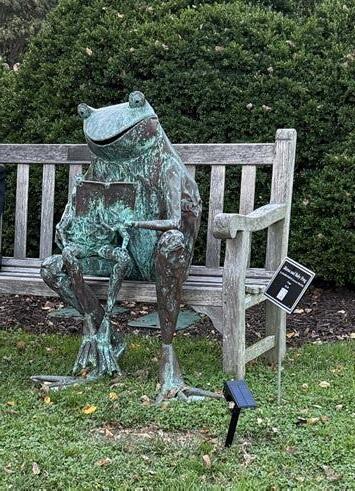


By Ellen Isaacson and Cavit Ireland
Biodiversity is needed now more than ever, but it all starts with native plants. On Wednesday, September 17, the 15th annual Urban Tree Summit was held at the Silver Spring Civic Center. The event brought together experts and community leaders to explore that perspective on how preserving and expanding urban tree canopies can improve environmental health, social equity, and community resilience across the DMV region.
Quick Overview
The summit highlighted the urgent need to address “tree equity” in urban neighborhoods historically affected by disinvestment, where lack of shade exacerbates heat risks and environmental injustice. Panelists emphasized that true conservation goes beyond planting trees; it requires inclusive collaboration among residents, policy makers, nonprofits, and landowners to protect and nurture these vital green spaces.
Key themes included promoting biodiversity through diverse native plantings, managing urban pests with sustainable practices, and reimagining urban forestry as a driver for community engagement and economic opportunity. Innovative programs that reclaim and repurpose urban wood, encourage native tree planting, and integrate ecological principles into city planning were showcased as models for the future. Above all, the summit reinforced that urban tree conservation is a shared responsibility, essential for cooling cities, cleaning the air, supporting wildlife, and fostering healthier, more connected communities.
Protecting the urban canopy is not just an environmental goal; it’s a vital investment in the well-being and equity of all residents.
Tallamy’s Keynote
Living in harmony with nature is our only viable option moving forward: This was Dr. Doug Tallamy’s keynote message. For life to continue on Earth, we must shift our perspective away from molding the environment to fit our needs. We must stop trying to conquer nature and instead coexist with it.
Tallamy, the T.A. Baker Professor of Agriculture in the Department of Entomology and Wildlife Ecology at the University of Delaware, discussed all things insects and native plants, and nothing could steal the audience’s attention; it was captivating. The author of the New York Times best- seller Nature’s Best Hope emphasized the need for a new approach to landscaping and conservation, one that prioritizes growing native species, removing invasive ones, and letting insects do what they do best: support ecosystems.
Tallamy reminded us that nature is built from millions of specialized interactions, ones that cannot be sustained in a concrete jungle. Life on Earth would perish without the interactions between plants, animals, and insects. These delicate relationships— bees pollinating flowers, birds dispersing seeds, and caterpillars feeding on native plants—are each a vital link in the web of life. As a society, we need to prioritize these species rather than aimlessly destroying them and their environments for our own agendas, Tallamy said.
In his latest book, How Can I Help, Tallamy outlines just that. In 2021, he cofounded Homegrown National Park with Michelle
Alfandari. Homegrown’s mission is to regenerate biodiversity, which fosters healthy, productive ecosystems that humans rely on to survive. Their vision was to turn hope into action. Tallamy is reminding gardeners that even though the problem seems insurmountable, something as simple as planting a native species in Maryland, like the black oak tree or the Black-eyed Susan (the state flower), will help make a difference. Undervalue nature, and we risk losing the very system that sustains us.
New approaches to land conservation go beyond native species and biodiversity; they foster communities. That was the lasting message from the panel that followed Tallamy’s talk, where three leading voices in urban land stewardship shared their vision for greener, more connected cities.
Panel on Preservation
Kelly Collins Choi with Casey Trees, Matt Gerhart with the Northern Virginia Conservation Trust, and Mia Rothberg from the Maryland-National Capital Park and Planning Commission discussed the challenges and triumphs of preserving the urban canopy in the region. Each panelist brought unique insights from their work in Washington, Virginia, and Maryland, but all three were in agreement on one core principle: Land conservation must involve locals.
Whether it’s homeowners planting and protecting mature trees, institutions partnering to preserve green spaces, or policymakers crafting smarter strategies, land conservation thrives when it’s rooted in relationships. Rothberg highlighted several treeplanting initiatives in the Maryland and DC areas, such as Reforest Montgomery’s free tree programs and native tree discounts,
which motivate residents to restore native species and boost local biodiversity. As the panelists emphasized, the future of conservation depends on collaboration between the public and private sectors, across jurisdictions, and in the communities they aim to serve.
Preserving the urban canopy isn’t just about aesthetics or ecology; it’s about safeguarding the living systems that sustain city life. Nature doesn’t thrive in isolation, and neither do we.
Equity and Trees
On sweltering summer days in Baltimore, MD, the line between shade and sun is also a divider between privilege and disadvantage. Decades of highway construction and redlining has left many predominantly Black neighborhoods with inadequate tree cover, which increases exposure to dangerous levels of heat. Environmental activists like Dr. Lemir Teron call “low tree equity” an urgent issue.
At the Urban Tree Summit on Wednesday, Teron, an associate professor of Earth, Environment, and Equity at Howard University, spoke with passion and a drive to increase ecological community resilience, while expressing the need to reduce the risk of potential disasters that may strike urban environments. What he called the “Playbook,” is a detailed plan towards an equitable urban canopy. City street trees face urgent issues like invasive species, drainage, and extreme heat during the hotter months. Proper funding and proactive planting are crucial steps in providing habitable areas for plants.
Trees cool down hot streets, clean the air, and even reduce risk of natural disasters like floods. However, the communities that need them most are typically the least likely to see any action from the city. Teron argued that city planning has brought observable, severe environmental consequences, killing ecology with highways, redlining, and “environmental racism.”
Now, Baltimore is making a push for urban planning by way of democracy. To make positive change in the community, the conversations should include residents, landscapers, forestry groups, and others who have been long excluded from taking part in these decisions, Teron said. However, questions remain. Who will fund these projects? Who will set the agenda? Whose voice is still not being heard?
Reclaimed Urban Wood
In the heart of Baltimore, what was once a Civil War base is being remodeled into a center for sustainability. Camp Small has become a hub for wood reclamation and reuse. Under the guidance of Recycling Coordinator Shaun Preston, the site processes more than 8,000 tons of logs, tree stumps, and organic materials that are repurposed into tables, dressers, or other artisan items. For kids, they can find new nature exploration areas in parks, schools, and at the zoo.
Not all wood that passes through Camp Small is equal, though. To an untrained eye, a pile of logs is just that, but Preston can pick out rarities: wooden gems. The economic potential of finding a single black walnut log is striking. Once milled, kiln-dried, and cut into finished boards, the wood from that one log can create nearly $100,000 worth of new products.
While speaking at the Urban Tree Summit, Preston said this program plants trees, maintains them, and educates the community in an effort to “change the mindset of how people see trees.” He believes that it’s an achievable goal with the support of the parks department and a healthy community effort.
What used to be called a “stump dump” is now a 4.5-acre blueprint for urban forestry. Even after battling a devastating fire in December 2024, Camp Small continues to thrive. One way is through the Baltimore Wood Project. This initiative partners with artists, community groups, business, and institutions like the Maryland Zoo to transform salvaged lumber into dressers, art, or firewood.
Working with the Baltimore Tree Trust and Cylburn Arboretum Center, Camp Small is also encouraging work development. Training programs that teach forestry, sawmill, and woodshop skills are helping people reimagine not only lumber, but their own lives, too. Preston has plans to expand the operation into biofuel, thermally modified wood, and cross-laminated timber, which will expand the output of high-quality products for the community and local businesses at a discounted rate, helping stimulate the local economy.
Urban Tree Choices
Our city streets are guarded by silent watchers that cool us with shade, clean the air of pollutants, and bring natural beauty to brick neighborhoods: trees. An alarming
and expanding amount of studies suggest that there is a better way to manage these urban forests. There are ways to mitigate the mounting health and biodiversity crises, and a lot can be done just by planting more of a variety. It sounds simple, but it’s far from easy.
Dr. Karin T. Burghardt, a professor of entomology at the University of Maryland, highlighted issues and potential solutions for urban forestry improvement, focusing on Baltimore. She stressed the need for plant-insect interactions during her speech on Wednesday and the importance of a “community ecology.” The core of the issue is a widespread preference for monocultural plantings that are efficient to plant and easy to forget about, ignoring an integral, longterm plan that serves as a living part of the city.
Researchers note that planting rows of the same tree species, like the Bradford pear, gives the perfect opportunity for pest and disease damage. For instance, one study showed that cicadas prefer monocultures to lay their eggs. Insects and illness can sweep down a city block without restriction, easily contaminating a large area of tree cover. On the other hand, impermeable surfaces and unhealthy soil put more stress on trees and their roots. Deteriorating urban canopies disproportionately raise temperatures, typically in redlined communities. This leaves entire blocks in Baltimore exposed to extreme heat on hot summer days.
Burghardt further stressed the need for an integrated pest management program (IPM) as a common sense-strategy that eliminates the need for harmful pesticides. IPM is a concept that protects plants by understanding pests, their life cycle, and what attracts them. By using behavioral signs, planters can figure out what plants will thrive in certain areas, where pests gravitate, and other factors that can be considered in planning the most effective urban forest.
Trees Matter
Overall, the 2025 Urban Tree Summit was an insightful and informative day that ideally left those in attendance feeling a little bit more optimistic about the future of urban forestry. o
Ellen Isaacson and Cavit Ireland are seniors in the Philip Merrill College of Journalism at the University of Maryland. This fall semester, they are both interns with Washington Gardener Magazine
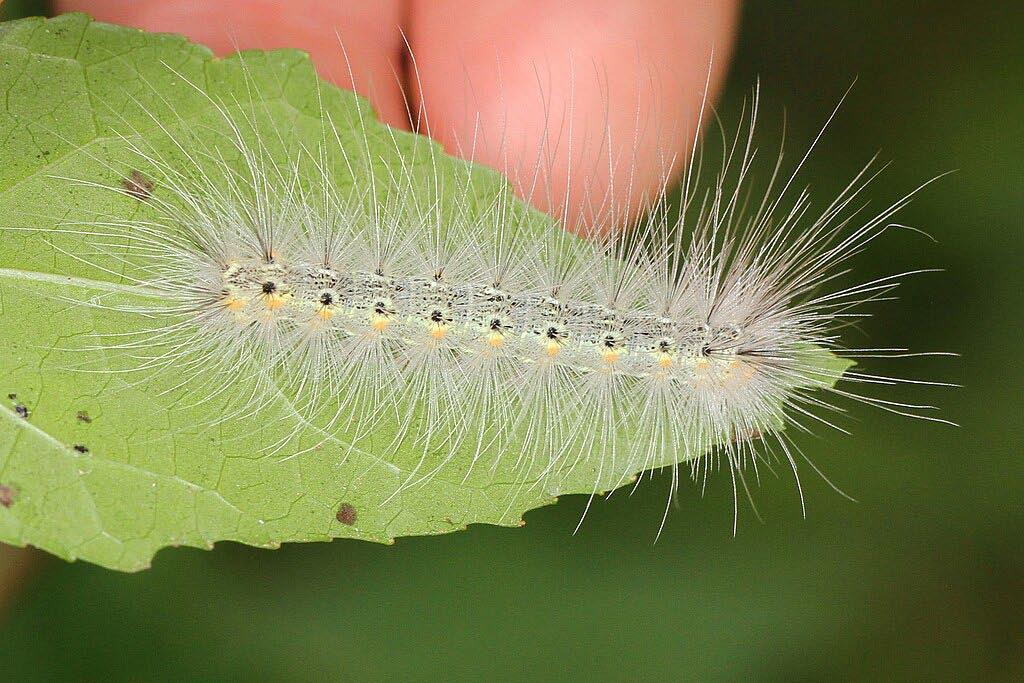
Fall Webworm
By Carol Allen
Most folks are familiar with the unsightly webs that form in cherry and crabapple trees in the spring. Those are the work of Eastern tent caterpillars (Malacosoma americanum), and although we don’t like how they look, those early spring caterpillars feed a lot of baby birds. They can be removed mechanically with a gloved hand, or the population can be diminished with a spray of a biological control such as Bacillus thuringiensis var. kurstaki or aizawai. The use of more generalist pesticides is discouraged. The insect’s feeding, although unsightly, is not damaging to larger trees, young trees may need protection.
What is not as well known is the forest tent caterpillar (Alacosoma disstria Hübner), which also emerges in the early spring. Where eastern tent caterpillars prefer host trees in the Rosaceae family, forest tent caterpillars prefer oaks, black gum, and other forest hardwoods. Eastern tent caterpillars form webs in the crotches of the tree’s branches while the forest tent caterpillar forms mats on branches and trunks. The forest tent caterpillar is the most widely distributed native tent caterpillar
in North American and can cause serious defoliation in natural areas.
While those two species are bothersome in the spring, the fall webworm (Hyphantria cunea) flourishes later in the year. Gardeners and hikers may have noticed webs on other trees in the garden and in natural areas. The fall webworm has a wide host range and can be found on more than 100 tree species, including mulberry, walnut, hickory, elm, sweetgum, poplar, willow, oak, linden, ash, apple, and other fruit trees.
In our region, the moths are active in the late spring for the first generation and from August to October for the second. Further south, they may see up to four generations. What is interesting is the adult moths that live above the 40th parallel are generally white, whereas the more southern populations are spotted. The 40th parallel cuts through the middle of Pennsylvania.
The second-generation eggs are laid by August and hatch within one to two weeks. The egg masses can be found on the underside of the host plant leaves. The iridescent green eggs are laid in masses of 400 to 1,000. The
female may cover the eggs with scales from her abdomen and will die after laying her eggs.
The southern population larvae may have a red head capsule, where the northern population’s head may be black. The larvae start covering their leaf with webbing soon after hatching and will skeletonize the leaf they are on. As they grow, they move on to new leaves, expanding the web as they go. Mature larvae develop hairs, and their bodies can be green with black spots or a darker color over all.
The pupa can be found in the leaf litter or in crevices in the bark of the host tree. The fall webworm over-winters in the pupal stage.
This species is gregarious and larval numbers can be high, so control will be more effective with early scouting in the garden. Remove the webs manually and/or spray with a Bt product as with Eastern tent caterpillars.
In forested areas where the trees are healthy, the damage, although unsightly, is not severe. There are many insect natural enemies, both parasitoids and predators, and they are welcome food for birds. Avoid spraying with generalist chemicals because those will kill as too many beneficial species. o
Carol Allen describes herself as a committable plant-a-holic. She has more than 25 years’ experience in the horticulture industry, with a special interest in plant pests and diseases; is a Licensed Pesticide Applicator in the state of Maryland; and is an ISACertified Arborist. She can be contacted at carolallen@erols.com.
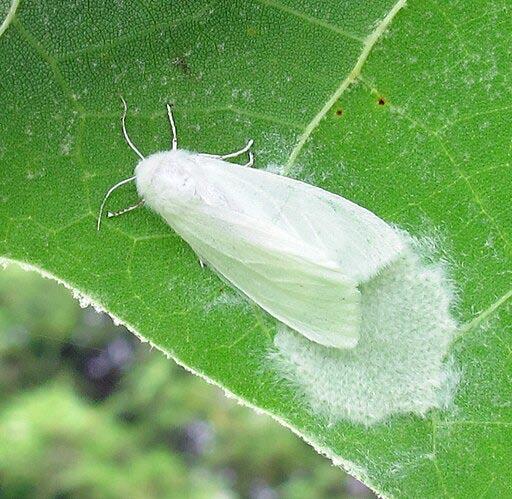
Fall Webworm (Hyphantria cunea) in Woodbridge, Virginia. Photo by Judy Gallagher, CC BY 2.0 <https://creativecommons.org/licenses/by/2.0>, via Wikimedia Commons.
Hyphantria cunea female photo by Jacy Lucier, CC BY-SA 4.0 <https://creativecommons.org/licenses/by-sa/4.0>, via Wikimedia Commons.
Lemon Verbena

By Barbara Melera
Lemon Verbena is a native of South and Central America. Unlike most herbs whose native habitats are the Mediterranean regions of Western Asia, Africa, and Southern Europe, and made their ways from the Old World to the New World, Lemon Verbena was a New World discovery that made its way to the Old World.
This unassuming, deciduous shrub (deciduous meaning the plant loses its leaves in the fall) was “discovered” by the Spanish conquistadors in Argentina and Chile in the 1500s. In its native habitats, the shrub can reach heights of 10–15 feet and is a perennial.
However, in the temperate climates of North America, Lemon Verbena is usually grown as a container plant, where it reaches heights of 2–4 feet. It is exceptionally sensitive to cold temperatures. When exposed to temperatures in the 40s, it frequently loses all of its leaves. Even a light frost can kill the plant.
Lemon Verbena, because of its New World origins, is not associated with the folklore stories and historic traditions of most other popular herbs. Its rise to popularity is the result of its incredible lemony fragrance that the plant easily produces just by someone brushing against its leafy stems. Today, Lemon Verbena is most often grown and used to make a delicately flavored tea.
Lemon Verbena has never been widely used for medicinal purposes, but has been used in folk medicine to aid
digestion, as a sedative, and to reduce fevers.
From a culinary perspective, the dried or fresh leaves can brighten the taste of fish or poultry and have been added to vegetable marinades, salad dressings, jams, puddings, and beverages. I have used the leaves to top sweet fruit salads in the summertime.
Lemon Verbena is an outstanding aromatic that can be used in potpourris and sachets. The oils of the plant can be used to make lovely soaps and bath oils. During the Victorian Era (1837–1901), sprigs of Lemon Verbena were placed in finger bowls for each guest to freshen their hands at elegant dinner parties. The delightful fragrance is so strong that it takes twice as many leaves of Lemon Balm to match the strength of Lemon Verbena.
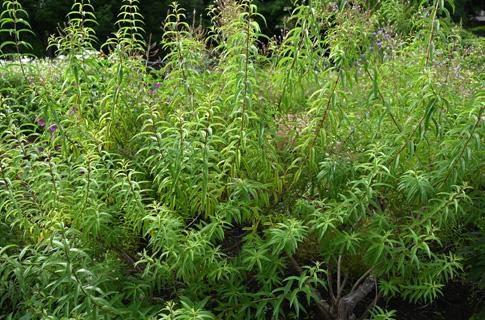
Growing Lemon Verbena
Lemon Verbena is not an easy plant to start and does require attention to grow successfully. We recommend that you start with seedlings. Mature plants do not routinely produce seeds and the
seeds have poor germination. Starting with seedlings is much easier and much more likely to be successful.
Cuttings should be taken in August, but make sure your “Mother Plant” is very healthy and planted in rich soil that has been kept moist but not soggy. The Mother Plant tends to wilt when cuttings are taken. Cuttings are difficult to root, so take at least six from a mature plant. Use a rooting gel or powder on the cut end to aid in rooting. Once rooted, the seedlings will grow easily if fed and watered.
Lemon Verbena plants are heavy feeders. Weekly or bi-weekly feedings of fish emulsion or a general fertilizer (5–5–5 or 10–10–10) are highly recommended. To keep the plant bushy, pinch the tips about every 6 weeks.
Lemon Verbena leaves can be harvested throughout the season, but the oils and fragrance are strongest in late summer.
In North America, Lemon Verbena plants do best when grown in containers, one plant in an 8–10 inch pot. This will be its forever home. Fill the container with soil to within 1 inch of the top and make sure to keep the soil moist.
Many gardeners put their potted Lemon Verbena plants outside during the summer. Do not put the plants outside until the evening temperatures are in the mid to high 50s. They should be moved into a shady area for about 2 weeks and then to full sun. In the fall, the plants should be brought in before the nighttime temperatures start into the 40s. Before moving them inside, prune the plants cutting all the thin or straggly stems. These stems will just compromise the vigor of the plant while it is indoors. In all likelihood, the plant will shed all its leaves when brought inside, but the leaves will grow back. Inside, the leaves are yellow-green. Outside, the leaves are more gray-green.
When the plants are brought indoors, their soil should be kept moist and they should be fed every 2 weeks. When soil needs to be replenished, use a potting mix and top-dress it with compost. o
Barbara Melera is president of Harvesting History (www.harvesting-history.com), a company that sells horticultural and agricultural products, largely of the heirloom variety, along with garden tools and equipment.
Waxing Eloquent About Waxwings
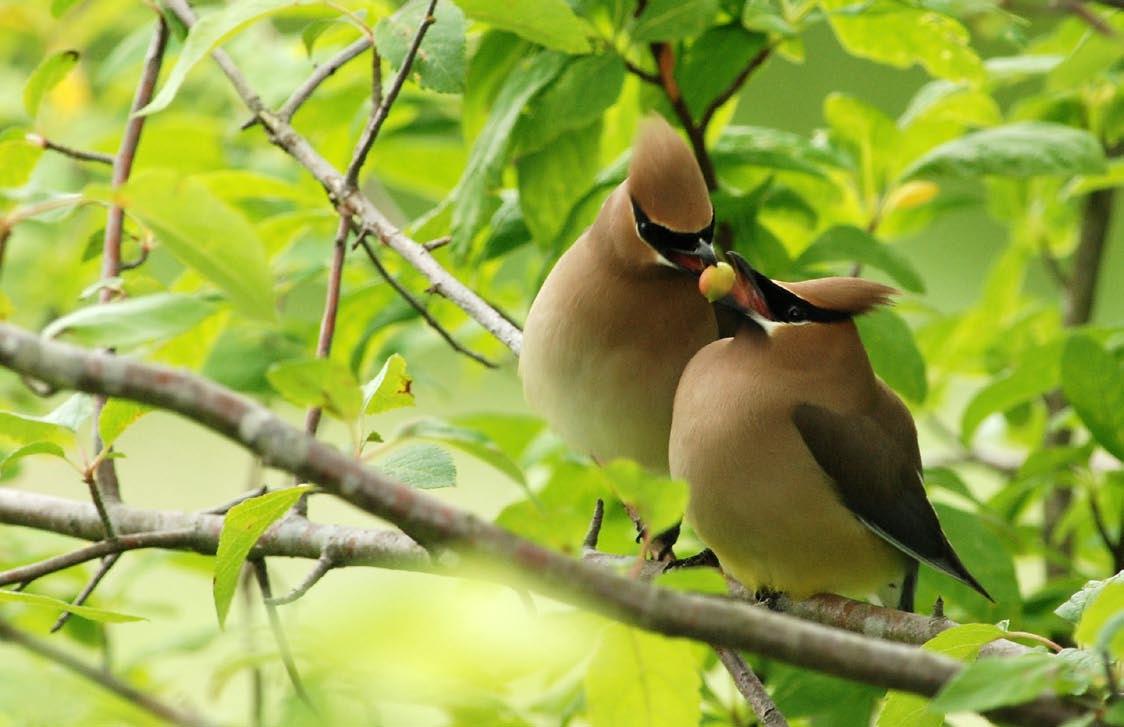
By Rick Borchelt
If you plant them, they will come. “Them” in this case are berryproducing trees and shrubs. “They” are cedar waxwings.
Cedar waxwings are the Crayola crayons of the bird world: silky-soft birds the size of a cardinal in a cocoa-brown feather wrapper, just like a crayon. And just like a crayon, they have brightly colored tips on both their wings and their tails. The colorful tips of some of their wing feathers even derive from crayonlike wax! Their common name, in fact, arises from the resemblance of the wax on their wing feathers to the wax used in antiquarian times for sealing letters and important documents.
Their scientific name, Bombycilla cedrorum, is also a comment on waxwings’ plumage. Ancient Greek gives us the root bombux, or silky, while cilla hails from the Latin word for tail. Germans call their nearly identical Bohemian waxwings Seidensschwanz—literally translated as silk-tail. The species name cedrorum means “of the cedars,” probably because the small, berry-like cones of junipers (colloquially called cedars) are a favorite food of Bohemian
waxwings, just as it is for cedar waxwings.
Cedar waxwings also have topknot crests that are more or less permanently raised and a rakish Zorro mask across almost the entirety of their faces. The overall impression is of a crisp, dashing thief raiding your berry bushes.
Waxwings are one of the few birds outside the tropics whose diet is almost exclusively made up of berries. The fruit feasting starts in May with mulberries and cherries, and continues through the summer with elderberries, blackberries, serviceberries, and blueberries. They hit the jackpot in early fall, when dogwoods, grapes, spicebush, and hollies offer ripe berries for the picking.
Their dependence on fruit has had profound impacts on waxwings’ ecology and behavior. The best way to describe them is peripatetic; they may travel hundreds of miles in search of the best berries.
They also time nesting to coincide with the availability of berries they eat; active waxwing nests can be found in our area anytime from late spring until
early fall, whenever there is an abundance of berries.
This is one bird species whose fate seems to be secure, and in fact, it’s thriving—and even increasing—throughout the U.S. One reason for their robust population health is that they’ve learned to eat the berry bonanza from introduced ornamental plants in our yards and gardens. Pyracantha is one of their favorites, as is the wide range of Asian hollies.
Particularly here in the East, they gorge on the half-dozen or so species of invasive Asian bush honeysuckles. In the fall, you can tell which waxwings have been feeding in these honeysuckles—the pigment in the berries after digestion ends up in the tips of the waxwings’ tail feathers, turning them from their normal yellow to a distinctive honeysuckle-berry orange.
Waxwings’ predilection for nonnative berries to pad their diet sometimes has dire consequences, however. One popular ornamental shrub, heavenly bamboo (Nandina domestica), is especially problematic. Nandina berries contain precursors to toxic hydrogen cyanide. If
A courtship berry gift from one waxwing to another.
Photo by Minette Layne.
birds eat too many (waxwings are prone to gorging), the toxin can prove fatal. Luckily, they don’t like Nandina very much and usually only turn to it at the end of winter, when all the other berries are gone. Wildlife-conscious gardeners can cut the berries off in late January or February to prevent an accidental avian poisoning incident.
Waxwings are also notorious for eating over-ripe, fermenting berries where the sugars have turned to alcohol. One of the waxwing’s other common names, cherry bird, reflects their undying passion for cultivated cherries, which ferment rather quickly when they ripen. There are many humorous reports of waxwings lolling about on the ground under cherry trees in spring, drunk as a proverbial sailor on leave. Here’s a video of a waxwing flock drunkenly gorging on holly berries: tinyurl.com/ yfw9cdwx.
Gregarious is also an apt descriptor for waxwings; it’s unusual to see solo birds. More typically, they arrive in small flocks to descend on a tree in fruit or a clump of berry bushes. They keep up a constant chatter unlike the calls of any of our other songbirds: a high-pitched cross between a tinkle and a whistle. In fact, despite the waxings’ gaudy fashion accents, a gardener’s first clue they have a waxwing invasion on their hands is this distinctive bird banter, which you can hear on this video: tinyurl.com/ ywza8m44.
Waxwings preen each other and share food, too. Especially when there is a juicy cluster of berries at the end of a branch that will hold only one bird, you’ll see that bird pluck berries and pass them down a line of waiting waxwings behind it. Food gifts also form an important part of pair bonding.
But if you want waxwings (and unless you have designs on those cherries for a pie yourself, who doesn’t?), planting a seasonal smorgasbord of waxwing favorites will almost certainly guarantee you a dinner reservation from these roving rascals every time they visit your neighborhood. o
Rick Borchelt is a science and natural history writer, field naturalist, and garden and botany enthusiast. Reach him with questions about this column at rborchelt@gmail. com.
Autumn Daffodil
By Kathy Jentz
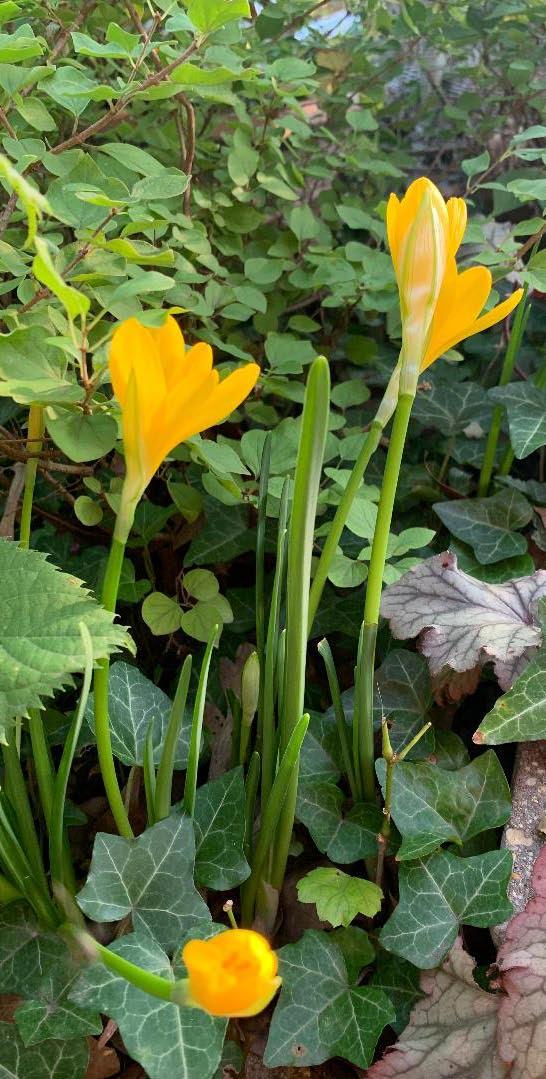
Autumn Daffodil (Sternbergia lutea) is also known as the winter daffodil, fall daffodil, lily-of-the-field, or yellow autumn crocus. It is actually not a daffodil or crocus at all, but is in the Amaryllis family. It is native to southern Europe.
This charming fall-blooming bulb is an old-fashioned favorite that deserves a spot in your garden. It is drought-tolerant, virtually pest-free, and both deer- and rabbit-resistant.
The Autumn Daffodil grows to about 6 to 8 inches high and has thin, strappy foliage that emerges in late summer; then the blooms appear in mid- to late September.
It is hardy to USDA Zones 6 to 9 and does best planted in full sun to part-shade in well-draining soils. If your soil is acidic, you might add lime to make it more alkaline and these bulbs happier.
Autumn Daffodil is an heirloom pass-along plant that will naturalize and form a small grouping. You can dig up and divide the bulbs to share them with others, or plant them around your garden. o
Kathy Jentz is the editor of Washington Gardener
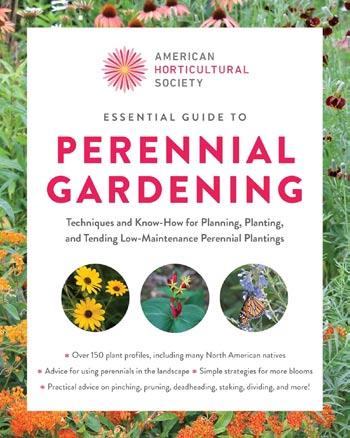
Essential Guide to Perennial Gardening, Techniques and Know-How for Planning: Planting, and Tending Low-Maintenance Perennial Plantings
Authors: American Horticultural Society
Publisher: Cool Springs Press
List Price: $28.99
Order Links: https://amzn.to/42exEYR and https://bookshop.org/ a/79479/9780760392836
Reviewer: Andrea Siegel
We think of perennials as the pretty plants that come back year after year in our gardens—same plant, same place, maybe spreading, and reliably thriving in our local climate and the growing conditions we provide. They spare us the time and effort of planting annuals, which, as that name suggests, last for but one season.
A wonderful 272-page guidebook from the American Horticultural Society is here to teach us best practices for designing and establishing lowmaintenance, eco-friendly gardens and landscapes with perennials or adding perennials to existing gardens. Essential Guide to Perennial Gardening: Techniques and Know-How for Planning, Planting, and Tending Low-Maintenance Perennial Plantings is more than a manual and less than a textbook, while combining the better aspects of each in a readable, enjoyable way. Readers come away with practical knowledge about soil composition, climate, how to create sustainable ecosystems, deal with pest control and the like, in addition to learning a lot about plants.
The book is mostly about herbaceous perennials, and contains a wealth of information.
This is the second guidebook by the American Horticultural Society, locally headquartered in Northern Virginia; the first is about organic vegetable gardening. The book about perennials has a forward-looking approach and overall focus on healthy, diverse gardens, which is timely, given the challenges gardeners face today, what with weather extremes, invasive insects, diseases, and pests. It reaches into these and other contemporary concerns. Especially with perennials, gardeners are looking ahead for seasons to come with lovely gardens and many want those gardens to sustain pollinators and other wildlife.
The book is unusually helpful because it explains the why behind the what, with information from earlier chapters continually woven into later chapters, reinforcing the relevancy of the information so the parts are always coming together. Chapters are presented in the logical order of gardening.
U.S. Department of Agriculture plant hardiness zones? Great start. What about growing conditions? Cloudy skies? Soggy ground? Soil type? Long, hot summer? Long, icy winter, but not always? Gardeners read about these before reaching chapters about garden ecosystems, garden style and the plants for it, how to shop for and propagate those plants, ways to prepare the garden bed and install the plants, what constitutes good mulch, and how to maintain the garden (low maintenance does not mean no maintenance). All this helps get the right plants in the right places and thrive. Context is everything.
The how-to components in the book are step-by-step, easy to follow; charts and boxes provide essential information.
The guide offers basic garden design help, which may not be enough for some readers, since creating a garden can be more challenging than expected—although the authors do say that hiring a professional is always an option. However, the many photos of gorgeous gardens show plant combinations that can be sources for ideas.
(I’ve watched shoppers walk around nurseries with photos of gardens they like and show a salesperson.)
The approach to pesticide use last resort, limited and the contemporary advice regarding pollinators and other wildlife may disappoint some gardeners, though others may love it.
The illustrated profiles of some 150 perennials is a welcome end to a book that is a useful resource. I recommend this book for beginners and experienced gardeners alike. o
Andrea Siegel is a master gardener in Maryland.
Magicka:
Finding
Spiritual Guidance
Through Plants, Herbs, Crystals, and More
Author: Carlota Santos
Publisher: Artisan Publishers Order Link: https://amzn.to/3VBHpN5 and https://bookshop.org/ a/79479/9781648292033
List Price: $20.00
Reviewer: Ellen Isaacson
Magic is in the eye of the beholder, and so is its interpretation. Magicka: Finding Spiritual Guidance Through Plants, Herbs, Crystals, and More is all about connecting with your spiritual side and letting labels fall to the wayside. The author, Carlota Santos, who is currently living in Spain, defines what magic is and the different types you may come across. She encourages her readers to let their intuition guide them and follow whatever resonates with them most. She shares her own experiences and what she does in her own magical space, but emphasizes that her method is one among many.
Santos demystifies the magical world throughout this book while preserving its whimsical nature with her illustrations. She brings the book to life with her artistic talents, illustrating the beauty of spirituality and magic with playful colors and lively characters.
Santos thoroughly explains the different concepts, terms, and practices that go into the magical realm, making Magicka digestible for magic rookies and connoisseurs alike. Santos explores different cultures and religions that incorporate magical practices while still respecting cultural differences.

Throughout this book, readers will learn about the energy of different crystals, Pagan holidays and their traditions, astrological signs, divination—and how to grow their own magical garden. Many different types of magic are associated with color as well as gardens.
Santos defines Green Magic as being familiar with natural elements, such as different types of plants, respecting them, and incorporating them into your magical practices.
For your magical garden, Santos does a deep dive into plants and herbs and their magical properties. She encourages her readers to grow their favorite plants in their gardens, so it’s easier to make a connection; talking to your plants is encouraged.
She describes different plants and herbs, along with their medical and magical properties, the element they’re associated with, and their origin. Want to improve your memory? Try growing rosemary in your garden. Looking for migraine relief? Try planting bay leaves in your next open plot. Feeling like your home is lacking peace and harmony? Fill your house with lilies; they are full of these qualities and help attract them.
Santos wants to help her readers find themselves through her work and recognize that there is magic in everyone, and it doesn’t take a special gift to explore it. o
Ellen Isaacson is an intern this fall semester with Washington Gardener. She is doublemajoring in journalism and French language and literature
The Self-Fed Farm and Garden: A Return to
the Roots of the Organic Method
Author: Eliot Coleman
Publisher: Chelsea Green Publishing
List Price: $29.95
Order Links: https://amzn.to/4nqAlPv and https://bookshop.org/ a/79479/9781645023067
Reviewer: Cavit Ireland
Eliot Coleman returns with a call to self-sustainability and refreshing takes on age-old techniques for homesteaders that maximize farm fertility. The renowned gardener succinctly illustrates the usefulness of the organic method with his first book in 15 years. The Self-Fed Farm and Garden weighs in on soil health and gives simple tricks that can transform harvests.
Healthy soil is the heart of the book; the captain of the garden. Coleman believes in biological farming, not chemical cultivation with pesticides and additives. Soil should be enriched on the farm itself, rather than brought in from an outside source. From his view, reliance on composts, manure, or packaged fertilizers creates complexities and unpredictabilities that can be avoided. Among other green practices, he praises shallow tilling, crop rotation, and cover crops, which promise flourishing yields and a healthier ecosystem.
“As I have always understood it, the original goal of organic farming was not to directly apply purchased fertilizers to plant food,” he writes.
Coleman brings his readers practical, realistic ideas that they can use. Decades of hands-on experience with year-round growing techniques at his Four Season Farm in Maine means that these practices are battle-tested and proven. In the book, readers can find detailed instructions about rotation, sowing, and fertilizing for different scenarios and different seeds. He breaks down soil science into explanations simple enough for a novice gardener to grasp but helpful to any advanced farmer as well.
For beginners, this book is welcoming and navigable. For seasoned growers, it may offer a new look at or refinement of practices they may already be familiar with. For the community, it’s a personal story adapted into a standard.
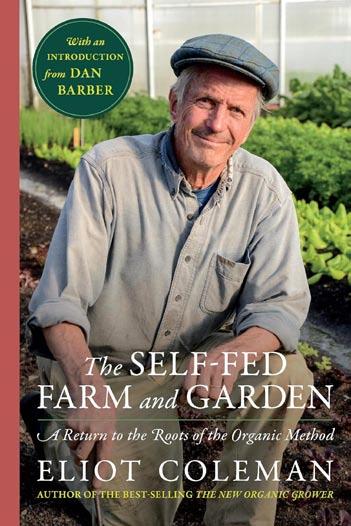
One thing worth noting is that most of Coleman’s experience comes from farming in Maine, which may need to be adjusted depending on your climate. Coleman reveals how different plants provide different benefits for enriching the soil throughout the seasons. Wondering how to boost nitrogen levels for next season? Green manure recipes from clover crops and peas have you covered. Need to keep weeds at bay? Try some rye. These are just a glimpse of the mastery that he uses to share his message that fertility is cultivated by a process, not bought overnight.
It’s a message the gardening community needed. Confusion about what can be considered organic has blurred the lines between greenhouse and laboratory, and contamination in commercial composts has steered the public away from store-bought starters. Forever chemicals feed uncertainty while Coleman’s tried and true self-fed philosophy is both timely and timeless.
“My interest in having a self-fed farm is practical, not irrational. It stems from my desire for dependable perpetual production of exceptional quality food that can’t be sidetracked by a sudden unavailability of inputs,” he writes. o
Cavit Ireland is an intern this fall semester with Washington Gardener. He is a rising senior at the University of Maryland studying journalism and hosts Sonic Fruit, a weekly music program on WMUC 90.5.

Creating and Caring for Shade Gardens
By Melinda Myers
Those shady spots in the landscape can make it challenging to grow a beautiful garden. Fortunately, more plants than you may think will thrive in low light.
Monitor the amount of sunlight the area receives throughout the day, season, and year. You may be surprised that it gets more sunlight than you thought. Some plants, like spring ephemerals and even sun-loving spring flowering bulbs, receive sufficient sunlight early in the season before most trees leaf out. Other plants need sunlight throughout the growing season and those sunloving plants growing in DC’s hot summers often benefit from a bit of afternoon sun.
Make a list of plants you have had success with and those that failed in the shady location. Use these to help you select or avoid plants with similar light requirements. For example, if peonies bloom and tomatoes produce fruit, this area receives quite a bit of sunlight, enough to grow most full-sun plants. Consider mulching the soil when there is more shade than even shade-loving plants can tolerate. Add a table and
chair for relaxing, and a few steppers if needed, to enjoy the cool shade.
When planting under or near trees, be careful not to damage them in creating your shade garden. Don’t bury, cut, dig, or shave off surface roots—that creates entryways for harmful insects and diseases.
Skip adding soil over the roots because even an inch can kill some tree species. Avoid deep cultivation that damages the fine feeder roots critical for water and nutrient absorption. Keep in mind that the majority of tree roots grow in the top 18" of soil, with 50% of these in the top six inches.
Instead, carefully dig relatively small planting holes between major roots, then mulch, and spot-water new plantings to minimize root damage. It may take transplants a little longer to fill in, but your trees will be healthier and live longer. Add a splash of color with a few potted annuals set among the perennials, or permanently sink a few pots in the ground and set potted flowering plants in them. It’s easier on the tree roots and your back.
Check soil moisture several times a week and water thoroughly as needed. Plants growing under large trees or overhangs need more-frequent watering, especially in the first two years, until they become established. The dense canopy of many trees and impervious overhangs prevent rainfall from reaching the ground below. The extensive root systems of trees and shrubs also absorb much of the rainfall that does make it through.
Avoid high-nitrogen, quick-release fertilizers that promote lush succulent growth that is more susceptible to insects and diseases. With limited light as a potential plant stressor, this can increase the risk of problems. Use a low-nitrogen, slowrelease fertilizer that promotes steady above and below-ground growth.
Protect new plantings especially hostas, impatiens, caladiums, coleus, turtleheads, wax begonias, Solomon seal, and other plants often damaged by deer and rabbits. Apply animal repellents before the animals start browsing for better results. Select a rain- and snowresistant product, like organic Plantskydd (plantskydd.com), so you won’t need to reapply as often. Always check the product label and follow the directions for the best results.
With proper plant selection and care, you can create a beautiful shade garden for years of enjoyment. o
Melinda Myers has written more than 20 gardening books, including Midwest Gardener’s Handbook, 2nd Edition and Small Space Gardening. She hosts The Great Courses “How to Grow Anything” instant video and DVD series and the nationally syndicated Melinda’s Garden Moment radio program. Myers is a columnist and contributing editor for Birds & Blooms magazine and was commissioned by Tree World Plant Care for her expertise in writing this article. Her website is www.MelindaMyers.com.
Pictured above, a shade garden with hostas, Solomon seal, and coleus grown in pots. Photo courtesy of MelindaMyers.com.



BACK ISSUE SALE!
YOU CAN REQUEST A SINGLE COPY OF PRINT BACK ISSUES FOR $6 EACH OR ANY 6 BACK ISSUES FOR $24, OR ALL 40+ PRINT BACK ISSUES FOR JUST $100. PRICE INCLUDES POSTAGE AND HANDLING. PLEASE SPECIFY THE ISSUE DATE(S). ORDER MUST BE PREPAID BY CHECK OR MONEY ORDER. SEND ORDERS TO: WASHINGTON GARDENER, 826 PHILADELPHIA AVE., SILVER SPRING, MD 20910
MARCH/APRIL 2005
• Landscape
•
•
• Cherry
• Stunning Plant Combinations
• Turning Clay into Rich Soil
• Wild Garlic
• Strawberries
JULY/AUGUST 2005
• Water Gardens
• Poison Ivy
• Disguising a Sloping Yard
• Kenilworth Aquatic Gardens
SEPTEMBER/OCTOBER 2005
• Container Gardens
• Clematis Vines
• Sponge Gardening/Rain Gardens
• 5 Insect Enemies of Gardeners
NOVEMBER/DECEMBER 2005
• Backyard Bird Habitats
• Hellebores
• Building a Coldframe
• Bulb Planting Basics
JANUARY/FEBRUARY 2006
• Garden Decor Principles
• Primroses
• Tasty Heirloom Veggies
• U.S. Botanic Garden
MARCH/APRIL 2006
• Top 10 Small Trees and Large Shrubs
• Azaleas
• Figs, Berries, & Persimmons
• Basic Pruning Principles
MAY/JUNE 2006
• Using Native Plants in Your Landscape
• Crabgrass
• Peppers
• Secret Sources for Free Plants
JULY/AUGUST 2006
• Hydrangeas
• Theme Gardens
• Agave
• Find Garden Space by Growing Up
SEPTEMBER/OCTOBER 2006
• Shade Gardening
• Hosta Care Guide
• Fig-growing Tips and Recipes
NOVEMBER/DECEMBER 2006
• Horticultural Careers
• Juniper Care Guide
• Winter Squash Growing Tips and Recipes
• Layer/Lasagna Gardening
JANUARY/FEBRUARY 2007
• Indoor Gardening
• Daphne Care Guide
• Asparagus Growing Tips and Recipes
• Houseplant Propagation
MARCH/APRIL 2007
• Stormwater Management
• Dogwood Selection & Care Guide
• Early Spring Vegetable Growing Tips
• Franciscan Monastery Bulb Gardens
MAY/JUNE 2007
• Roses: Easy Care Tips
• Native Roses & Heirloom Roses
• Edible Flowers
• How to Plant a Bare-root Rose
JULY/AUGUST 2007
• Groundcovers: Alternatives to Turfgrass
• How to Pinch, Prune, & Dead-head
• William Paca House & Gardens
• Hardy Geraniums
SEPTEMBER/OCTOBER 2007
• Succulents: Hardy to our Region
• Drought-Tolerant Natives
• Southern Vegetables
• Seed Saving Savvy Tips
NOVEMBER/DECEMBER 2007
• Gardening with Children
• Indoor Bulb-Forcing Basics
• National Museum of the American Indian
• Versatile Viburnums
JANUARY/FEBRUARY 2008
• Dealing with Deer
• Our Favorite Garden Tools
• Delightful Daffodils
MARCH/APRIL 2008
• Patio, Balcony, Rooftop Container Gardens
• Our Favorite Garden Tools
• Coral Bells (Heuchera)
MAY/JUNE 2008
• Growing Great Tomatoes
• Glamorous Gladiolus
• Seed-Starting Basics
SUMMER 2009
• Grow Grapes in the Mid- Atlantic
• Passionflowers
• Mulching Basics
• Growing Hops
FALL 2009
• Apples
• How to Save Tomato Seeds
• Persimmons
WINTER 2009
• Battling Garden Thugs
• How to Start Seeds Indoors
• Red Twig Dogwoods
• Unusual Edibles to Grow in Our Region
SPRING 2010
• Community Gardens
• Building a Raised Bed
• Dwar f Iris
• Broccoli
SUMMER 2010
• Fragrance Gardens
• Watering Without Waste
• Lavender
• Potatoes
FALL 2010
• Vines and Climbers
• Battling Stink Bugs
• Russian Sage
• Garlic
WINTER 2010
• Paths and Walkways
• Edgeworthia
• Kohlrabi
you trying to reach thousands of gardeners in the greater DC region/MidAtlantic area? Washington Gardener Magazine goes out in the middle of every month. Contact kathyjentz@gmail.com or call 301.588.6894 for ad rates (starting from $200). The ad deadline is the 5th of each month. Please submit your ad directly to: kathyjentz@gmail.com
Got a Garden Question?
Got a gardening question you need answered? Send your questions to KathyJentz@gmail. com and use the subject line “Q&A.”
Please also include your first name, last initial, and what city and state you are writing from. Then look for your answered questions in upcoming issues.
SOLDOUT!SOLDOUT!SOLDOUT!
SPRING 2011
• Cutting-Edge Gardens
• Final Frost Dates and When to Plant
• Bleeding Hearts
• Onions
• Flavorful Fruiting Natives
JULY/AUGUST 2008
• Landscaping with Ornamental Grasses
• Edible Grasses to Graze On
• Slug and Snail Control
• Sage Advice: Sun-Loving Salvias
SEPTEMBER/OCTOBER 2008
• Autumn Edibles — What to Plant Now
• Beguiling Barrenworts (Epimediums)
• Best Time to Plant Spring-blooming Bulbs
• 14 Dry Shade Plants Too Good to Overlook
NOVEMBER/DECEMBER 2008
• Outdoor Lighting Essentials
• How to Prune Fruiting Trees, Shrubs, Vines
• 5 Top Tips for Overwintering Tender Bulbs
• Harry Lauder’s Walking Stick
JANUARY/FEBRUARY 2009
• Compost Happens: Nature’s Free Fertilizer
• Managing Stormwater with a Rain Garden
• Visiting Virginia’s State Arboretum
• Grow Winter Hazel for Winter Color
MARCH/APRIL 2009
SUMMER 2011
• Ornamental Edibles
• Urban Foraging
• Amsonia/Arkansas Blue Star
• Growing Corn in the Mid- Atlantic
FALL 2011
• Herb Gardens
• Toad Lilies
• Sweet Potatoes
• Cool Weather Cover Crops
WINTER 2011/EARLY SPRING 2012
• Green Roofs and Walls
• Heaths and Heathers
• Radishes
SPRING 2012
• Pollinator Gardens
• Brunnera: Perennial of the Year
• Growing Yacon
SUMMER 2012
• Tropical Gardens
• Captivating Canna
• Icebox Watermelons
SPRING 2013
• Great Garden Soil
• All About Asters
• 40+ Free and Low-cost Local Garden Tips
• Spring Edibles Planting Guide
• Testing Your Soil for a Fresh Start
• Redbud Tree Selection and Care
SOLDOUT!SOLDOUT!SOLDOUT!
• Squash Vine Borer
SUMMER/FALL 2013
• Miniature/Faerie Gardens
• Beguiling Abelias
• Best Viewing Spots for Virginia Bluebells
MAY/JUNE 2009
• Top Easy Summer Annuals for DC Heat
• Salad Table Project
• Grow and Enjoy Eggplant
• How to Chuck a Woodchuck
• Growing Great Carrots
WINTER/EARLY SPRING 2014
• Ferns for the Mid-Atlantic
• Chanticleer Gardens
• Beet Growing Basics
Jentz Prints
Antique Botanical Prints for the decorator, collector, connoisseur, and art lover.
Jentz Prints can be purchased most weekends (weather-dependent) at the world-famous Eastern Market.
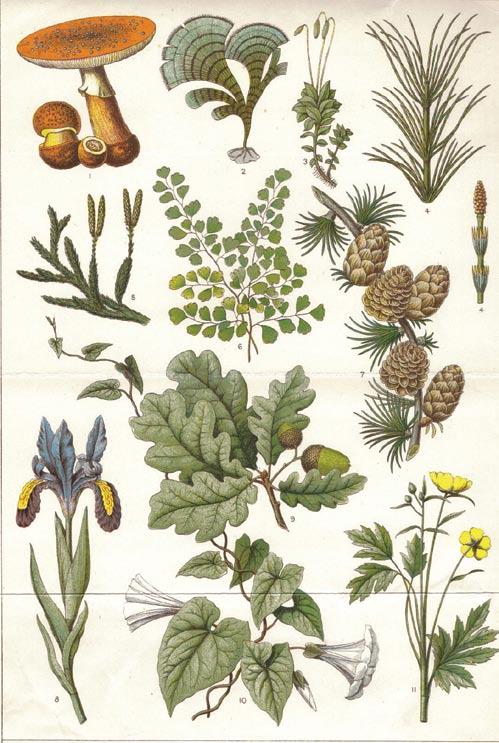
Antique prints are affordable—most in the $10-$30 range—and they are the perfect gift idea for that plant lover in your life. And don’t forget to buy a few for yourself! For more information or to get a detailed show schedule, please contact Jentz Prints by email at UllrichJ@aol.com.
